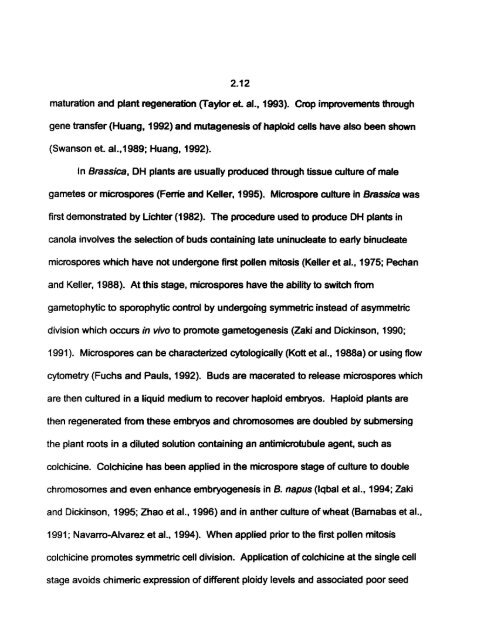The Application of Ooubled Haploid Plants to Population ... - MSpace
The Application of Ooubled Haploid Plants to Population ... - MSpace
The Application of Ooubled Haploid Plants to Population ... - MSpace
Create successful ePaper yourself
Turn your PDF publications into a flip-book with our unique Google optimized e-Paper software.
2.12<br />
maturation and plant regeneration (Tayfor et al., 1993). Crop impmvements through<br />
gene transfer (Huang, 1992) and mutagenesis <strong>of</strong> haploid cells have also been shown<br />
(Swanson et. aL.1989; Huang, 1992).<br />
In Brassica. DH plants are usually produced through tissue culture <strong>of</strong> male<br />
gametes or microspores (Feme and Keller, 1995). Microspore culture in Bmsic6 was<br />
first demonstrated by Lichter (1982). <strong>The</strong> procedure used <strong>to</strong> produce OH plants in<br />
canola involves the seledion <strong>of</strong> buds containing late uninucleate <strong>to</strong> early binucieate<br />
microspores which have not undergone first pollen mi<strong>to</strong>sis (Keller et al.. 1975; Pechan<br />
and Keller. 1988). At this stage, microspores have the ability <strong>to</strong> switch fiom<br />
game<strong>to</strong>phytic <strong>to</strong> sporophytic control by undergoing symmetric instead <strong>of</strong> asymmetric<br />
division which occurs in vivo <strong>to</strong> promote game<strong>to</strong>genesis (Zaki and Dickinson. 1990;<br />
1991 ). Microspores can be characterized cy<strong>to</strong>logically (Kott et al., 1988a) or using flow<br />
cy<strong>to</strong>metry (Fuchs and Pauls, 1992). Buds are macerated <strong>to</strong> release microspores which<br />
are then cultured in a liquid medium <strong>to</strong> recover haploid embiyos. <strong>Haploid</strong> plants are<br />
then regenerated frorn these embryos and chromosomes are doubled by submersing<br />
the plant roots in a diluted solution containing an antimicrotubule agent, such as<br />
colchicine. Colchicine has been applied in the microspore stage <strong>of</strong> culture <strong>to</strong> double<br />
chromosomes and even enhance embryogenesis in B. napus (Iqbal et al., 1994; Zaki<br />
and Dickinson, 1995; Zhao et al., 1996) and in anther culture <strong>of</strong> wheat (Barnabas et al..<br />
1991 ; Navarro-Alvarez et al.. 1994). When applied prior <strong>to</strong> the first pollen mi<strong>to</strong>sis<br />
colchicine p<strong>to</strong>motes symmetric cell division. <strong>Application</strong> <strong>of</strong> colchicine at the single cell<br />
stage avoids chimenc expression <strong>of</strong> different ploidy levels and associated poor seed







![an unusual bacterial isolate from in partial fulf]lment for the ... - MSpace](https://img.yumpu.com/21942008/1/190x245/an-unusual-bacterial-isolate-from-in-partial-fulflment-for-the-mspace.jpg?quality=85)





![in partial fulfil]ment of the - MSpace - University of Manitoba](https://img.yumpu.com/21941988/1/190x245/in-partial-fulfilment-of-the-mspace-university-of-manitoba.jpg?quality=85)


